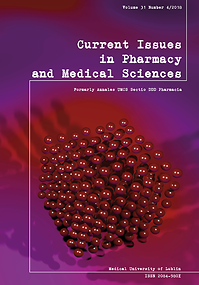The Relationship Between Marginal Bone Loss Around Dental Implants and the Specific Characteristics of Implant-Prosthetic Treatment
DOI:
https://doi.org/10.1515/cipms-2018-0019Keywords:
dental implants, marginal bone loss, humansAbstract
The marginal bone loss around dental implants is an important indicator that helps to evaluate the course and the final outcome of implant-prosthetic treatment. It is, therefore, important to understand the factors that may affect this. The aim of the study was to assess the impact of the specific characteristics of implant-prosthetic treatment on the marginal bone loss around implants. The study included 28 patients, aged 37-66 years, treated with dental implants. Every patient received at least one of the two types of implants: with Morse taper connection and with internal hexagonal connection. The average marginal bone loss around the implants was evaluated on the basis of the panoramic radiographs. The maximum follow-up period after implantation was 46 months. The peri-implant marginal bone loss was evaluated taking into consideration the implant localisation, the procedure of sinus lift with bone augmentation, implant type, implant diameter, vertical implant position relative to the compact bone level and the type of prosthetic restoration, the time between implantation and loading with prosthetic restoration, as well as the time between loading and the measurement of marginal bone loss. The correlation between bone loss and the selected characteristics of the treatment was assessed using generalised estimating equations (GEE). An objective analysis was enabled via the applied research model: evaluation of an impact of the specific implant-prosthetic treatment characteristics on peri-implant marginal bone loss in patients treated with implants with different implant-abutment interface systems. The results of the study showed that peri-implant marginal bone loss increased significantly with implant localisation in canine sites (compared to the localization in premolar sites), as well as with prosthetic restorations in the form of dentures (compared to bridges), and decreased when implants were placed below the compact bone level (compared to those placed at the bone level). At the same time, marginal bone loss was not significantly related to implant diameter or to the sinus lift procedure. The results obtained seem extremely useful in everyday clinical practice.
References
1. Papaspyridakos P, Chen JC, Singh M, et al. Success criteria in implant dentistry: a systematic review. J Dent Res. 2012;91(3):242-8.
2. Szpak P, Szymańska J. Marginal bone behavior around the dental implants with regard to the patient’s characteristics. Curr Issues Pharm Med Sci. 2017;30(1):36-8.
3. Szymańska J, Szpak P. Marginal bone loss around dental implants with various types of implant-abutment connection in the same patients. J Pre-Clin Clin Res. 2017;11(1):30-4.
4. Szpak P, Szymańska J. The survival of dental implants with different implant-abutment connection systems. Curr Issues Pharm Med Sci. 2016;29(1):11-3.
5. Hardin J, Hilbe J. Generalized Estimating Equations. London: Chapman and Hall/CRC; 2003.
6. Liang K-Y, Zeger S. Longitudinal data analysis using generalized linear models. Biometrika. 1986;73(1):13-22.
7. Jansen R, Lerch J, Schillinger C, et al. The tissue care concept. Important factors for long-term stability of hard and soft tissue. iDENTity. 2007;(2):8-11.
8. Rasouli Ghahroudi AAR, Talaeepour AR, Mesgarzadeh A, et al. Radiographic vertical bone loss evaluation around dental implants following one year of functional loading. J Dent. 2010;7(2): 89-97.
9. Chou CT, Morris HF, Ochi S, et al. AICRG Part II: Crestal bone loss associated with the ANKYLOS implant: loading to 36 months. J Oral Implantol. 2004;30(3):134-43.
10. Machtei EE, Frankenthal S, Blumenfeld I, et al. Dental implants for immediate fixed restoration of partially edentulous patients: a 1-year prospective pilot clinical trial in periodontally susceptible patients. J Periodontol. 2007;78(7):1188-94.
11. Levin L, Sadet P, Grossmann Y. A retrospective evaluation of 1,387 single-tooth implants: a 6-year follow up. J Periodontol. 2006;77(12): 2080-3.
12. Bratu EA, Olimpiu K, Radu S. Study of bone level around osseointegrated dental implants. MIS News. 2007;19(7): 2-3.
13. Bratu EA, Tandlich M, Shapira L. A rough surface implant neck with microthreads reduces the amount of marginal bone loss: a prospective clinical study. Clin Oral Implants Res. 2009;20: 827-32.
14. Weng D, Nagata MJ, Bell M, et al. Influence of microgap location and configuration on the periimplant bone morphology in submerged implants. An experimental study in dogs. Clin Oral Implants Res. 2008;19(11):1141-7.
15. Szymańska J, Szpak P. Marginal bone loss around dental implants with conical and hexagonal implant-abutment interface: A literature review. Dent Med Probl. 2017;54(3): 279-84.
16. Yi J-M, Lee J-K, Um H-S, et al. Marginal bony changes in relation to different vertical positions of dental implants. J Periodontol Implant Sci. 2010;40(5):244-8.
17. Weng D, Nagata MJ, Leite CM, et al. Influence of microgap location and configuration on radiographic bone loss in nonsubmerged implants: an experimental study in dogs. Int J Prosthodont. 2012;24(5):445-52.
18. Tandlich M, Ekstein J, Reisman P, Shapira L. Removable prostheses may enhance marginal bone loss around dental implants: a long-term retrospective analysis. J Periodontol. 2007;78(12): 2253-9.
19. Tandlich M, Reizman P, Shapira L. The incidence of the marginal bone loss and failure rate of MIS internal hex implants bearing different types of prosthesis. MIS News. 2006;17:2-3.
20. Bryant SR, Zarb GA. Crestal bone loss proximal to oral implants in older and younger adults. J Prosthet Dent. 2003;89(6):589-97.
Downloads
Published
Issue
Section
License
Copyright (c) 2018 Authors

This work is licensed under a Creative Commons Attribution-NonCommercial-NoDerivatives 3.0 Unported License.


